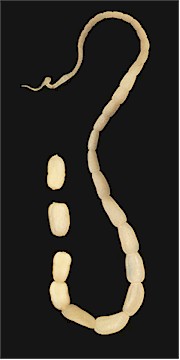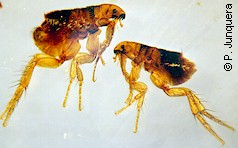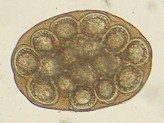Dipylidium caninum, also called the dog tapeworm, the flea tapeworm or the double-pore tapeworm is a parasitic flatworm very common in dogs and occasionally also in cats and some wild canids (e.g. foxes). It can also infect humans, especially children.
Dipylidium caninum is found worldwide.
The disease caused by Dipylidium caninum is called dipylidiasis.
Dipylidium caninum does not affect cattle, sheep, pigs, horses or poultry.
Are dogs or cats infected with Dipylidium caninum contagious for humans?
- YES. Not directly through contact with the infected pet or its feces, but by accidental ingestion of fleas or lice infected with cysticercoids of the tapeworm. For additional information read the chapter on the life cycle below.
You can find additional information in this site on the general biology of parasitic worms and/or tapeworms.
Final location of Dipylidium caninum
Predilection site of adult Dipylidium caninum is the small intestine.
Anatomy of Dipylidium caninum

Adult Dipylidium caninum can be up to 70 cm long and 2-3 mm wide. They have the typical flattened form of a tapeworm and have a whitish color.
The head (called scolex) measures about 0.5 mm and has hooks and suckers for attaching to the wall of the intestine. The main body (called strobila) has usually between 50 and 150 segments (called proglottids). Gravid segments that are shed with the host's feces are up to 1 cm long and 2-3 cm wide.
Otherwise, as other tapeworms, Dipylidium caninum has neither a digestive tube, nor circulatory or respiratory systems. It doesn't need them because each proglottid absorbs what it needs directly through its tegument.
Each proglottid has its own, reproductive organs of both sexes (i.e. they are hermaphroditic) and excretory cells known as flame cells (protonephridia). The reproductive organs in each proglottid have a common opening called the genital pore. In young proglottids all these organs are still rudimentary. They develop progressively, which increases the size of the proglottid as it moves towards the tail.
Mature gravid proglottids are full of eggs and detach from the strobila (i.e. the chain of segments) to be shed outside the host with its feces.
The eggs have an oval to almost spherical form and are quite small (~35 to 40 micrometers). Each egg contains an already developed larva (oncosphere or hexacanth). Eggs are initially encapsulated in groups of 5 to 20 eggs. As many other tapeworms, Dipylidium caninum can produce millions of eggs during its lifetime.
Life cycle and biology of Dipylidium caninum
Dipylidium caninum has an indirect life cycle with dogs (as well as other canids and occasionally cats) as final hosts, and fleas or lice as obligate intermediate hosts.

The eggs of adult worms in the intestine of the final host are shed with its feces mostly in the form of gravid segments full of eggs. Once outside the segments the eggs are released, which are ingested by flea larvae or lice. Lice can also ingest eggs that contaminate the pet's hair coat.
The eggs hatch in the intestine of these intermediate hosts and the young tapeworm larvae penetrate into their body cavity (hemocoel), where they develop to cysticercoids. After metamorphosis, adult fleas or lice carry the infective cysticercoids.
The final hosts, mainly dogs, ingest contaminated fleas or lice when licking or biting themselves as a reaction to itching caused flea or lice bites. Once in the intestine of the final host, digestion of the fleas or lice releases the cysticercoids, which complete their development to adults, attach to the gut's wall and start producing segments.
Humans, especially children become infected through intense contacts with pets, especially mouth to mouth, which should be discouraged.
The prepatent period (time between infection of the final hosts and first eggs shed with the feces) is 2 to 3 weeks.
Harm caused by Dipylidium caninum infections, symptoms and diagnosis
Infections of dogs with Dipylidium caninum are mostly benign and show no clinical signs, both for pets and humans. In cases of infections with numerous tapeworms, which are very unusual, diarrhea or constipation, weight loss, restlessness, anal itching and abdominal pain have been reported. However, these symptoms are not specific for Dipylidium infections and can have other origins.
Detection of gravid segments (look lice rice grains) in the feces, around the anus or in the pet's nest strongly suggests a tapeworm infection. Diagnosis is confirmed by microscopic examination of fecal samples and identification of the eggs.
Prevention and control of Dipylidium caninum infections

The best way to prevent the infection of dogs and cats with Dipylidium caninum is to keep the pets free of fleas and lice, which are the intermediate hosts. To learn more read the specific articles in this site on the control of fleas and lice.
If a pet has a confirmed Dipylidium infection, there are numerous anthelmintic products that control such infections. They contain active ingredients with broad-spectrum anthelmintic efficacy such as benzimidazoles (e.g. fenbendazole, febantel, mebendazole) or specific taenicides such as praziquantel and epsiprantel, the latter often in combination with nematicides (e.g. levamisole, milbemycin oxime, pyrantel, etc.) to cover a broader spectrum of worms.
Most of these pet wormers are available in formulations for oral delivery either as solids (tablets, pills, etc.) or as liquids (drenches, suspensions, etc.). There are also a few injectable and spot-on (= squeeze-on = pipettes) taenicides in some countries (mainly with praziquantel).
Most wormers kill the worms shortly after treatment and are metabolized and/or excreted within a few hours or days. This means that they have a short residual effect, or no residual effect at all. As a consequence treated animals are cured from worms but do not remain protected against new infections. To ensure that they remain worm-free the pets have to be dewormed periodically, depending on age and the local epidemiological, ecological and climatic conditions.
Other classic livestock anthelmintics such as macrocyclic lactones (e.g. ivermectin, selamectin, etc.), levamisole, tetrahydropyrimidines (e.g. pyrantel, morantel) and piperazine derivatives are not effective at all against Dipylidium species or whatever tapeworms.
So far there are no antiparasitic medicines for external use such as shampoos, soaps, sprays, powders, insecticide-impregnated collars, etc. that control established tapeworm infections, although they can be effective preventatives if they control fleas and lice.
There are so far no vaccines against Dipylidium caninum. To learn more about vaccines against parasites of livestock and pets click here.
Biological control of Dipylidium caninum (i.e. using its natural enemies) is so far not feasible.
You may be interested in an article in this site on medicinal plants against external and internal parasites.
Resistance of Dipylidium caninum to anthelmintics
So far there are no reports on confirmed resistance of Dipylidium caninum to anthelmintics.
This means that if an anthelmintic fails to achieve the expected efficacy, chance is very high that it was not due to resistance but either the product was used incorrectly, or it was unsuited for the control of Dipylidium caninum. Incorrect use is the most frequent reason for failure of antiparasitic drugs.
|
Ask your veterinary doctor! If available, follow more specific national or regional recommendations for Dipylidium control. |